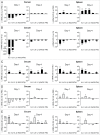Invasive behavior of Campylobacter jejuni in immunosuppressed chicken
- PMID: 27574876
- PMCID: PMC5411237
- DOI: 10.1080/21505594.2016.1221559
Invasive behavior of Campylobacter jejuni in immunosuppressed chicken
Abstract
Campylobacter jejuni is a predominant cause of gastroenteritis in humans but rather harmless in chickens. The basis of this difference is unknown. We investigated the effect of the chicken immune defense on the behavior of C. jejuni using glucocorticoid (GC)-treated and mock-treated 17-day old Ross 308 chicken bearing in mind that GCs have immunosuppressive effects and dampen the innate immune response. The effect of GC administration on the behavior of C. jejuni was compared with that on infection with Salmonella Enteritidis to address possible microbe-associated differences. Our results revealed that GC treatment fastened the intestinal colonization of C. jejuni (p < 0.001) and enhanced its dissemination to the liver (p = 0.007). The effect of GC on intestinal colonization of S. Enteritidis was less pronounced (p = 0.033) but GC did speed up the spread of this pathogen to the liver (p < 0.001). Cytokine transcript analysis showed an up to 30-fold reduction in baseline levels of IL-8 mRNA in the cecal (but not spleen) tissue at Day 1 after GC treatment (p < 0.005). Challenge with C. jejuni strongly increased intestinal IL-8, IL-6, and iNOS transcript levels in the non-GC treated animals but not in the GC-treated birds (P < 0.005). In vitro assays with chicken macrophages showed that GC dampened the TLR agonist- and C. jejuni induced-inflammatory gene transcription and production of nitric oxide (P < 0.005). Together, the results support the hypothesis that C. jejuni has the intrinsic ability to invade chicken tissue and that an effective innate immune response may limit its invasive behavior.
Keywords: Campylobacter; Toll-like receptor; chicken; colonization; glucocorticoids; innate immunity; invasion.
Figures






Comment in
-
The host-pathogen interaction in Campylobacter jejuni infection of chickens: An understudied aspect that is crucial for effective control.Virulence. 2017 Apr 3;8(3):241-243. doi: 10.1080/21505594.2016.1240860. Epub 2016 Sep 26. Virulence. 2017. PMID: 27668455 Free PMC article. No abstract available.
Similar articles
-
Campylobacter jejuni ST353 and ST464 cause localized gut inflammation, crypt damage, and extraintestinal spread during large- and small-scale infection in broiler chickens.Appl Environ Microbiol. 2025 Mar 19;91(3):e0161424. doi: 10.1128/aem.01614-24. Epub 2025 Feb 18. Appl Environ Microbiol. 2025. PMID: 39964091 Free PMC article.
-
A tolerogenic mucosal immune response leads to persistent Campylobacter jejuni colonization in the chicken gut.Crit Rev Microbiol. 2012 Feb;38(1):17-29. doi: 10.3109/1040841X.2011.615298. Epub 2011 Oct 13. Crit Rev Microbiol. 2012. PMID: 21995731 Review.
-
Campylobacter jejuni colonization promotes the translocation of Escherichia coli to extra-intestinal organs and disturbs the short-chain fatty acids profiles in the chicken gut.Poult Sci. 2016 Oct 1;95(10):2259-65. doi: 10.3382/ps/pew151. Epub 2016 May 3. Poult Sci. 2016. PMID: 27143773
-
Comparative in vivo infection models yield insights on early host immune response to Campylobacter in chickens.Immunogenetics. 2009 Feb;61(2):101-10. doi: 10.1007/s00251-008-0346-7. Epub 2008 Dec 12. Immunogenetics. 2009. PMID: 19082824
-
Re-thinking the chicken-Campylobacter jejuni interaction: a review.Avian Pathol. 2018 Aug;47(4):352-363. doi: 10.1080/03079457.2018.1475724. Epub 2018 Jun 11. Avian Pathol. 2018. PMID: 29764197 Review.
Cited by
-
Effect of the polysaccharide capsule and its heptose on the resistance of Campylobacter jejuni to innate immune defenses.Microbiologyopen. 2024 Feb;13(1):e1400. doi: 10.1002/mbo3.1400. Microbiologyopen. 2024. PMID: 38375546 Free PMC article.
-
Current Perspectives and Potential of Probiotics to Limit Foodborne Campylobacter in Poultry.Front Microbiol. 2020 Dec 22;11:583429. doi: 10.3389/fmicb.2020.583429. eCollection 2020. Front Microbiol. 2020. PMID: 33414767 Free PMC article. Review.
-
Impact of Eimeria tenella Coinfection on Campylobacter jejuni Colonization of the Chicken.Infect Immun. 2019 Jan 24;87(2):e00772-18. doi: 10.1128/IAI.00772-18. Print 2019 Feb. Infect Immun. 2019. PMID: 30510107 Free PMC article.
-
Feed Choice Led to Higher Protein Intake in Broiler Chickens Experimentally Infected With Campylobacter jejuni.Front Nutr. 2018 Sep 5;5:79. doi: 10.3389/fnut.2018.00079. eCollection 2018. Front Nutr. 2018. PMID: 30234123 Free PMC article.
-
Intestinal Colonization of Campylobacter jejuni and Its Hepatic Dissemination Are Associated with Local and Systemic Immune Responses in Broiler Chickens.Microorganisms. 2023 Jun 28;11(7):1677. doi: 10.3390/microorganisms11071677. Microorganisms. 2023. PMID: 37512849 Free PMC article.
References
-
- Ruiz-Palacios GM. The health burden of Campylobacter infection and the impact of antimicrobial resistance: playing chicken. Clin Infect Dis 2007; 44:701-03; PMID:17278063; http://dx.doi.org/10.1086/509936 - DOI - PubMed
-
- Havelaar AH, van Pelt W, Ang CW, Wagenaar JA, van Putten JP, Gross U, Newell DG. Immunity to Campylobacter: its role in risk assessment and epidemiology. Crit Rev Microbiol 2009; 35:1-22; PMID:19514906; http://dx.doi.org/10.1080/10408410802636017 - DOI - PubMed
-
- Newell DG, Fearnley C. Sources of Campylobacter colonization in broiler chickens. Appl Environ Microbiol 2003; 69:4343-51; PMID:12902214; http://dx.doi.org/10.1128/AEM.69.8.4343-4351.2003 - DOI - PMC - PubMed
-
- Van Deun K, Pasmans F, Ducatelle R, Flahou B, Vissenberg K, Martel A, Van den Broeck W, Van Immerseel F, Haesebrouck F. Colonization strategy of Campylobacter jejuni results in persistent infection of the chicken gut. Vet Microbiol 2008; 130:285-97; PMID:18187272; http://dx.doi.org/10.1016/j.vetmic.2007.11.027 - DOI - PubMed
Publication types
MeSH terms
Substances
LinkOut - more resources
Full Text Sources
Other Literature Sources
Medical
Miscellaneous
